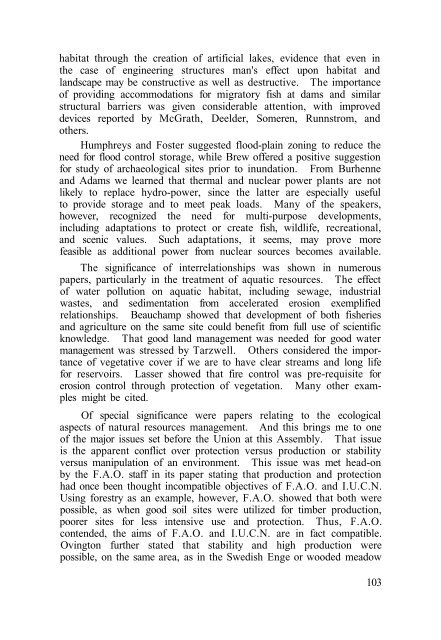septième réunion technique seventh technical meeting ... - IUCN
septième réunion technique seventh technical meeting ... - IUCN
septième réunion technique seventh technical meeting ... - IUCN
- No tags were found...
You also want an ePaper? Increase the reach of your titles
YUMPU automatically turns print PDFs into web optimized ePapers that Google loves.
habitat through the creation of artificial lakes, evidence that even in<br />
the case of engineering structures man's effect upon habitat and<br />
landscape may be constructive as well as destructive. The importance<br />
of providing accommodations for migratory fish at dams and similar<br />
structural barriers was given considerable attention, with improved<br />
devices reported by McGrath, Deelder, Someren, Runnstrom, and<br />
others.<br />
Humphreys and Foster suggested flood-plain zoning to reduce the<br />
need for flood control storage, while Brew offered a positive suggestion<br />
for study of archaeological sites prior to inundation. From Burhenne<br />
and Adams we learned that thermal and nuclear power plants are not<br />
likely to replace hydro-power, since the latter are especially useful<br />
to provide storage and to meet peak loads. Many of the speakers,<br />
however, recognized the need for multi-purpose developments,<br />
including adaptations to protect or create fish, wildlife, recreational,<br />
and scenic values. Such adaptations, it seems, may prove more<br />
feasible as additional power from nuclear sources becomes available.<br />
The significance of interrelationships was shown in numerous<br />
papers, particularly in the treatment of aquatic resources. The effect<br />
of water pollution on aquatic habitat, including sewage, industrial<br />
wastes, and sedimentation from accelerated erosion exemplified<br />
relationships. Beauchamp showed that development of both fisheries<br />
and agriculture on the same site could benefit from full use of scientific<br />
knowledge. That good land management was needed for good water<br />
management was stressed by Tarzwell. Others considered the importance<br />
of vegetative cover if we are to have clear streams and long life<br />
for reservoirs. Lasser showed that fire control was pre-requisite for<br />
erosion control through protection of vegetation. Many other examples<br />
might be cited.<br />
Of special significance were papers relating to the ecological<br />
aspects of natural resources management. And this brings me to one<br />
of the major issues set before the Union at this Assembly. That issue<br />
is the apparent conflict over protection versus production or stability<br />
versus manipulation of an environment. This issue was met head-on<br />
by the F.A.O. staff in its paper stating that production and protection<br />
had once been thought incompatible objectives of F.A.O. and I.U.C.N.<br />
Using forestry as an example, however, F.A.O. showed that both were<br />
possible, as when good soil sites were utilized for timber production,<br />
poorer sites for less intensive use and protection. Thus, F.A.O.<br />
contended, the aims of F.A.O. and I.U.C.N. are in fact compatible.<br />
Ovington further stated that stability and high production were<br />
possible, on the same area, as in the Swedish Enge or wooded meadow<br />
103
















